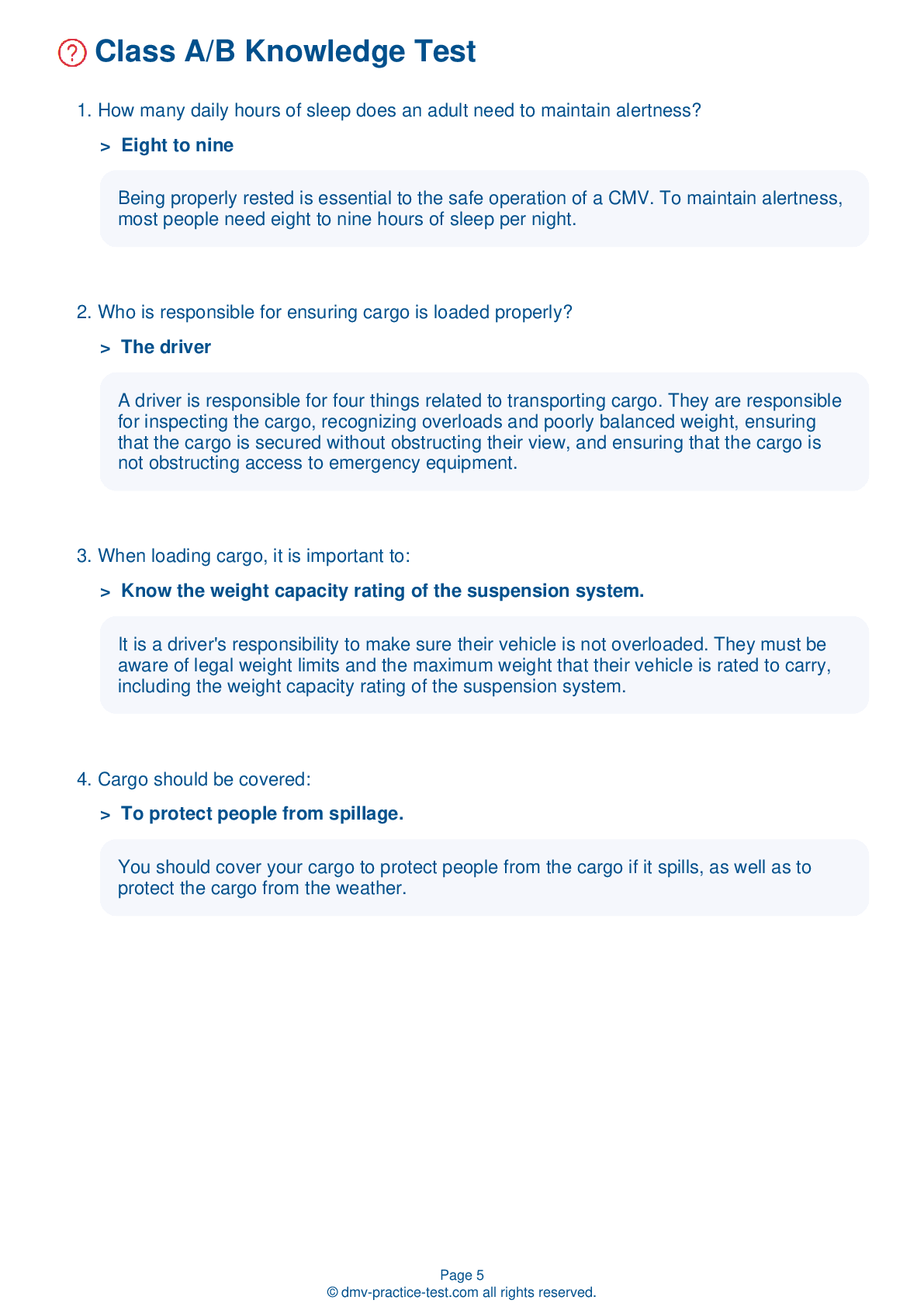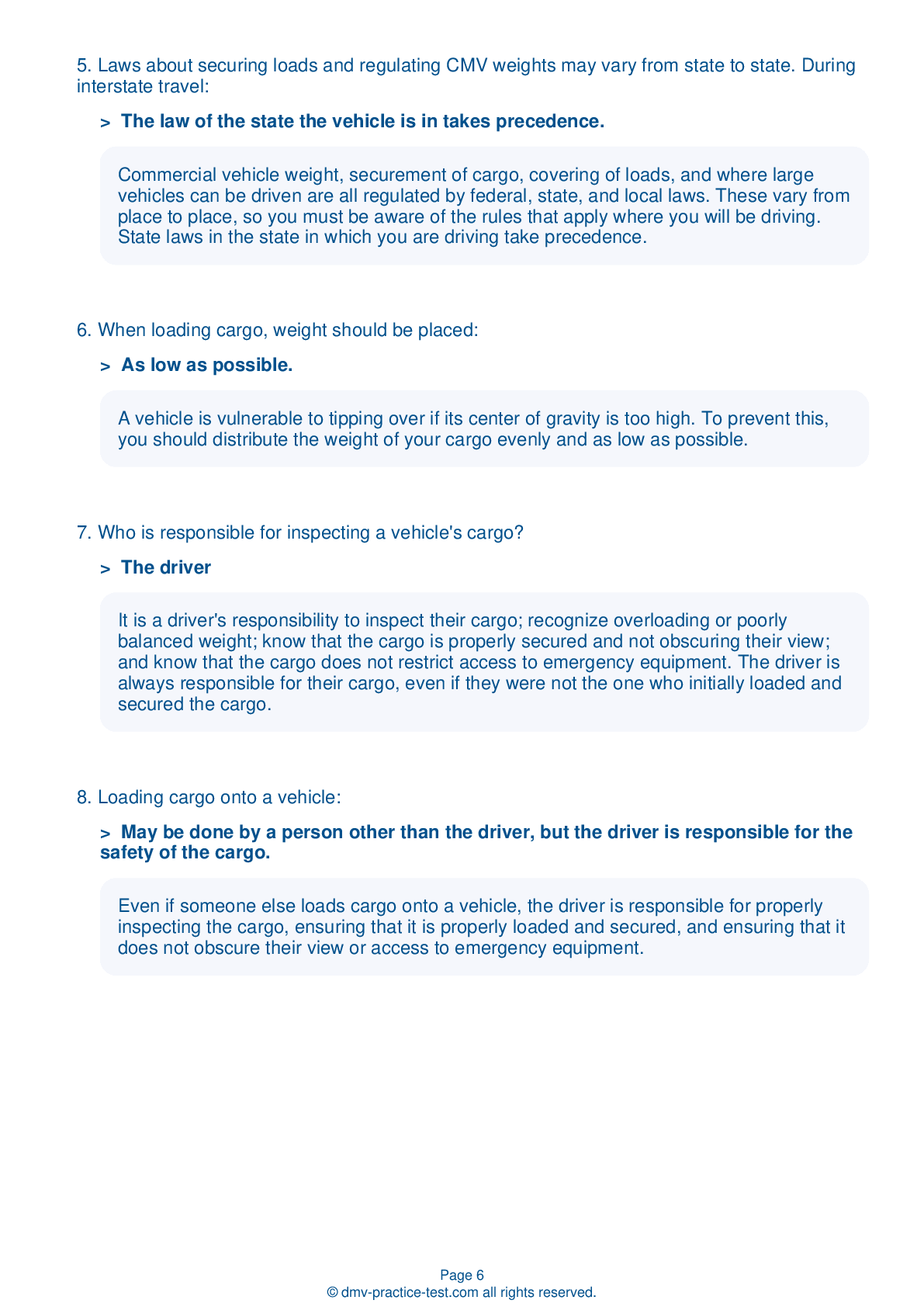Knowledge Test Class A #2
Class A Driving Test | Connecticut 2025 #2 Page 5 of 7
Train for FREE online with our Connecticut class A license test. The official exam test consists of several obligatory parts, with all of them checking your knowledge of different blocks of road rules. If you need to obtain a CT CDL class A permit in 2025, practice as much as possible. Free sample tests published on our website will help you check and improve your knowledge and boost your grades. Please bear in mind that CDL class A requirements may vary from state to state.
50
40
20
29 . If your automobile license is suspended:
You must tell your employer within 30 days if you are convicted of any traffic violation, aside from a parking violation, no matter which vehicle you were driving at the time of the violation. If your license is suspended, revoked, or canceled, or if you are otherwise disqualified from driving, you must tell your employer within two business days.
30 . Causing a fatality through negligent operation of a CMV can result in loss of a CDL for at least:
Two years.
A first conviction of causing a fatality through negligent operation of a CMV will result in the loss of your CDL for at least one year. A second conviction will result in loss of the CDL for life.
31 . Which of the following determines your blood alcohol concentration (BAC)?
The color of the drink
The three main factors that determine a person's blood alcohol concentration (BAC) are how much alcohol was consumed; how fast it was consumed; and the person's body weight. The only thing that can lower a person's BAC is waiting for the alcohol to leave their system naturally.
32 . If convicted of speeding while operating your personal automobile in a different jurisdiction, you should:
If you are convicted of any kind of traffic violation, in any type of vehicle, you must notify your employer within 30 days. You must also inform your motor vehicle licensing agency of the violation within 30 days if the conviction happened in another jurisdiction. This rule does not apply to parking infractions.
33 . A stopped bus:
Is a concern, whether passengers are visible or not.
Always drive cautiously around a stopped bus. Passengers may cross in front of or behind it, and the bus may prevent them from seeing your vehicle.
34 . When starting a vehicle with dual air brakes, pressure of ____ should be built up in the system before it is driven.
200 psi
Before driving a vehicle with a dual air brake system, allow time for the air compressor to build up pressure of at least 100 psi in both the primary and secondary systems.
35 . Once the air tanks are at an air pressure level of 125 psi, the air compressor governor will:
An air compressor governor will stop the compressor from pumping air once the air tanks are at an air pressure level around 125 psi. This air pressure level is referred to as the "cut-out" level.
2025 Connecticut | Frequently Asked Questions
A CDL Class A license in Connecticut allows the holder to operate any combination of vehicles with a Gross Combination Weight Rating (GCWR) of 26,001 pounds or more, provided the Gross Vehicle Weight Rating (GVWR) of the vehicle being towed is over 10,000 pounds. This typically includes tractor-trailers and truck and trailer combinations.
A Class A CDL license in Connecticut allows the holder to operate vehicles such as tractor-trailers, truck and trailer combinations, tank vehicles, livestock carriers, and flatbeds. The license is for any combination of vehicles with a Gross Combination Weight Rating (GCWR) over 26,001 pounds, if the towed vehicle exceeds 10,000 pounds GVWR.
To obtain a Class A CDL license in Connecticut, you must be at least 21 years old, possess a valid Connecticut driver's license, pass a vision test, and complete a commercial driver's license knowledge test. You must also pass a pre-trip vehicle inspection test and a skills test, which includes off-road maneuvers and on-road driving. Additionally, you must provide a medical examiner's certificate.
In Connecticut, you must be at least 21 years old to qualify for a Class A CDL license if you intend to drive across state lines (interstate). However, if you plan to drive only within Connecticut (intrastate), you can obtain a Class A CDL license at the age of 18.
Specific endorsements are not required for a Class A CDL license, but they can grant additional privileges. Endorsements include T for Double/Triple Trailers, P for Passenger Vehicles, N for Tank Vehicles, H for Hazardous Materials, and S for School Buses. Each endorsement requires passing a separate knowledge test and sometimes a skills test.
The Class A CDL skills test in Connecticut encompasses three main sections: a pre-trip vehicle inspection, a basic vehicle control test, and an on-road driving test. This assessment is designed to evaluate your ability to safely operate a Class A commercial vehicle, including checking for safety defects, maneuvering the vehicle in various situations, and driving in normal traffic conditions.
Yes, Class A CDL license holders may face limitations based on factors like the driver's medical condition, the type of vehicle driven, and the presence of certain endorsements. For example, drivers might be restricted to operating automatic transmission vehicles, or prohibited from driving tank or passenger vehicles without the appropriate endorsements. Also, all CDL holders must abide by federal hours-of-service regulations.
Yes, in Connecticut, the written Class A CDL test is available in multiple languages besides English. However, federal regulations require that all CDL holders understand English sufficiently to converse with the general public, understand highway traffic signs and signals, and respond to official inquiries and instructions.
Yes, you can request accommodations for the Class A CDL written test if you have a disability. The Connecticut DMV complies with the Americans with Disabilities Act (ADA) and provides reasonable accommodations like sign language interpreters, extra time, or tests in alternative formats. You should contact the DMV directly to arrange these accommodations prior to your test date.
If you fail the Class A CDL written test in Connecticut, you are allowed to retake it. However, you must wait a minimum of seven days before your next attempt. There is also a retest fee that applies each time you retake the test. It's recommended to study the CDL manual thoroughly before your next attempt.



